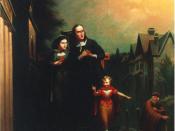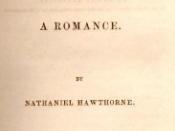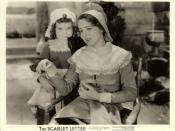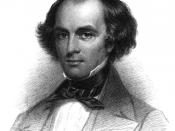Hawthorne's prolific use of symbolism in his works is what characterizes him as a great writer of American Literature. Hawthorne develops his symbols as if they were actually actors in his story. Hawthorne's symbols are the essence of The Scarlet Letter.
The Scarlet Letter "A"ÃÂ is the central symbol of the novel. It is intended to serve as a form of punishment for Hester Prynne's forbidden act of passion. It stands for "Adultery,"ÃÂ and is meant to be a constant source of torment. The vagueness of the symbol, however, allows its meaning to evolve as the novel progresses, thus "the scarlet letter had not done its office"ÃÂ (Hawthorne 160). Later on, the letter comes to stand for "Able,"ÃÂ as Hester is "Able"ÃÂ to overcome hardship, live through the shame, and thrive in the hypocritical Puritan society. Towards the end of her life, the letter grows to mean "Angel"ÃÂ, and "the scarlet letter ceased to be a stigma which the attracted world's scorn and bitterness"ÃÂ and it was even "looked upon with awe, yet with reverence too."ÃÂ
(260). The scarlet letter also forges a link between the characters. Pearl, for instance, can't see her mother without it; the scarlet letter had become a part of her mother.
The scaffold is another important symbol in the novel. It symbolizes Judgment Day and repentance. Hawthorne uses it whenever the plot takes a shift, as a sort of turning point, "each of the scaffold scenes brings together in a moment of moral, emotional, and psychological tension the major characters and forces of the story"ÃÂ (Martin 109). At the beginning, the scaffold is where Hester is sentenced to stand for three hours, as a kind of social punishment. Later, Dimmesdale goes to the scaffold as a place where he can escape from the anguish of his concealed transgression and the evil-hearted schemes of Roger Chillingworth. The last scaffold scene is when Dimmesdale finally confesses to his hidden sin, his act of passion with Hester, and dies there on the scaffold.
Pearl is probably the most symbolic of all the symbols used in the novel. She is so symbolic because she is so far from reality. Hawthorne frequently refers to how Pearl is so different from the other Puritan children, and how she is "impish"ÃÂ or "spritely"ÃÂ (Hawthorne 86-7). Even though Pearl is so far from reality, Pearl is what keeps Hester in touch with reality. She grounds Hester and, as Hawthorne explains, saves her mother from Satan's snare (110). Pearl also serves to connect Hester and Dimmesdale, and symbolizes the love they share for each other.
Hawthorne's use of color and light is very important in the development of the novel. "Images of color, and of light and shade are more numerous than any other images in the novel"ÃÂ (Waggoner 160). The color red stands for passion and the anguish felt by both Hester and Dimmesdale. It also stands for the love between the two of them and for Pearl, their daughter. Darkness and light symbolize the ongoing struggle between good and evil. The darkness is generally associated with Chillingworth, and the cold acts of revenge he exacts on Dimmesdale. The light stands for truth and purity and Pearl's free nature.
The Scarlet Letter is flowing over with symbolism. Understanding Hawthorne's symbols by themselves is key to understanding The Scarlet Letter as a novel.
Works Cited Hawthorne, Nathaniel. The Scarlet Letter. Austin: Holt, Rinehart and Winston, 1850.
Martin, Terence. Nathaniel Hawthorne. Rev. ed. Boston: Twayne Publishers, 1986.
Swisher, Clarice ed. Readings On Nathaniel Hawthorne. San Diego: Greenhaven Press, 1996.
Waggoner, Hyatt Howe. "Color and Light Images in The Scarlet Letter."ÃÂ Swisher 159-67.





